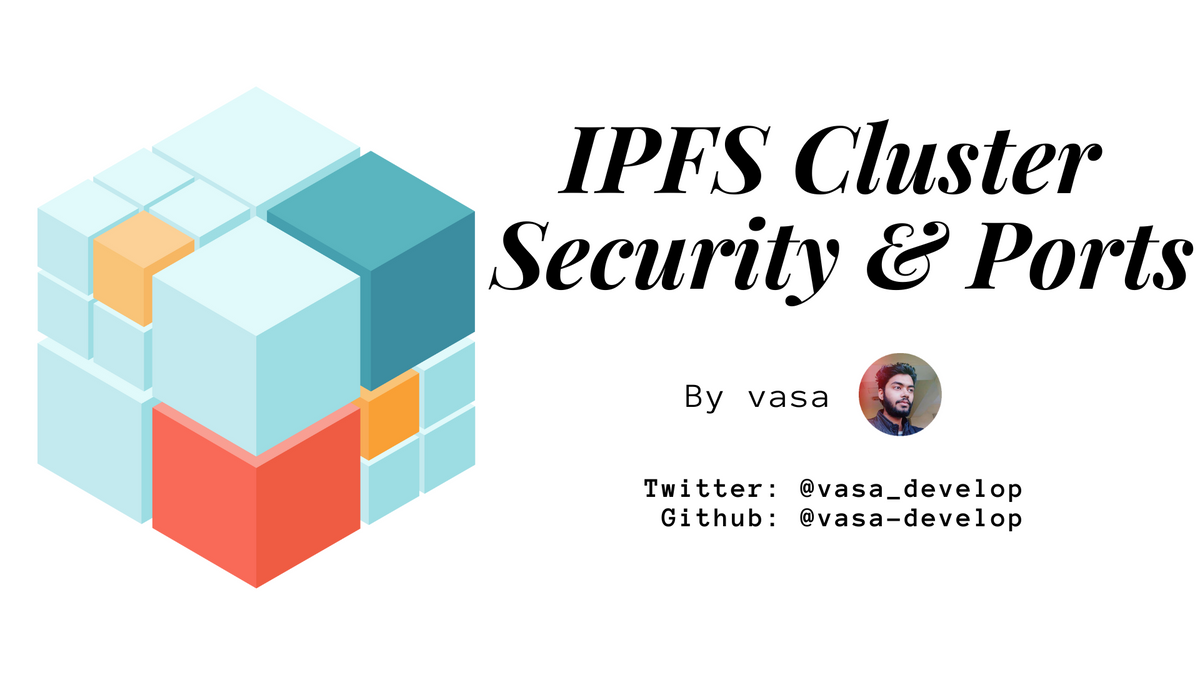IPFS Cluster Security & Ports

This section explores some security considerations when running IPFS Cluster.
There are four types of endpoints in IPFS Cluster to be taken into account when protecting access to the system. Exposing an unprotected endpoint might give anyone control of the cluster. Cluster configuration uses sensible defaults.
The cluster secret
The 32-byte hex-encoded secret in the service.json file acts as libp2p network protector. This provides additional encrytion for all communications between peers (libp2p) using a pre-shared key.
This makes it impossible to communicate with a peer’s swarm endpoint (see below) and thus, to send RPC commands to that peer, without knowing the secret in advance.
The secret is a security requirement for raft-based clusters which do not enforce any RPC authorization policy. CRDT-based clusters can run with an empty secret as long as trusted_peers is correctly set: only the peers in trusted_peers can modify the pinset and perform actions.
However, we recommend to set the secret in all cases, as it provides network isolation: clusters running without a secret may discover and connect to the main IPFS network, which is mostly useless for the cluster peers (and for the IPFS network).
The trusted_peers in CRDT mode
The trusted_peers option in the crdt section of the service.json file provides access control to the peer RPC endpoints and allows modifications of the pinset issued by the peers in that array (as identified by their peer IDs), but only apply to clusters running in crdt-mode.
Trusted peers can:
- Modify the pinset: indirectly trigger pin/unpin operations
- Trigger status sync operations (resulting in
ipfs pin ls) - Add content to the peer (resulting in
ipfs block put)
Non-trusted peers only have acccess to ID and Version endpoints (returning IPFS and Cluster Peer information).
trusted_peerscan be set to[ "*" ]to trust every other peer.
Ports overview
- Cluster swarm:
tcp:9096is used by the Cluster swarm and protected by the shared secret. It is OK to expose this port (the clustersecretacts as password to interact with it). - HTTP API:
tcp:9094can be exposed when enabling SSL and setting up basic authentication. - libp2p-HTTP API: when using an alternative libp2p host, for the api, the
libp2p_listen_multiaddresscan be exposed when basic authentication is enabled. - IPFS API:
tcp:5001is the API of the IPFS daemon and should not be exposed to other thanlocalhost. - IPFS Proxy endpoint:
tcp:9095should not be exposed without an authentication mechanism on top (nginxetc…). By default it provides no authentication nor encryption (similar to IPFS’stcp:5001)
Read the sections below to get a more detailed explanation.
Cluster swarm endpoints
The endpoint is controlled by the cluster.listen_multiaddress configuration key, defaults to /ip4/0.0.0.0/tcp/9096 and represents the listening address to establish communication with other peers (via Remote RPC calls and consensus protocol).
As explained above, the shared secret controls authorization by locking this endpoint so that only the cluster peers holding the secret can communicate. We recommend to never run with an empty secret.
HTTP API endpoints
IPFS Cluster peers provide by default an HTTP API endpoint which can be configured with SSL. It also provides a libp2p API endpoint, which re-uses either the Cluster libp2p host or a specifically configured libp2p host.
These endpoints are controlled by the restapi.http_listen_multiaddress (default /ip4/127.0.0.1/tcp/9094) and the restapi.libp2p_listen_multiaddress (if a specific private_key and id are configured in the restapi section).
Note that when no additional libp2p host is configured, the Cluster’s peer libp2p host (which listens on 0.0.0.0) is re-used to provide the libp2p API endpoint. As explained, this endpoint is only protected by the cluster secret.
Both endpoints support Basic Authentication but are unauthenticated by default.
Access to these endpoints allow to fully control an IPFS Cluster peer, so they should be adecuately protected when they are opened up to other than localhost. The secure channel provided by the configurable SSL or libp2p endpoint, along with Basic Authentication, allow to safely use these endpoints for remote administration.
The restapi configuration offers a number of variables to configure CORS headers. By default, Allow-Origin is set to * and Allow-Methods to GET. You should verify that this configuration is suitable for your needs, application and environment.
The HTTP API can be disabled altogether by removing the restapi section from the configuration, but then ipfs-cluster-ctl will be unable to talk to the peer.
IPFS and IPFS Proxy endpoints
IPFS Cluster peers communicate with the IPFS daemon (usually running on localhost) via plain, unauthenticated HTTP, using the IPFS HTTP API (by default on /ip4/127.0.0.1/tcp/9095.
IPFS Cluster peers also provide an unauthenticated HTTP IPFS Proxy endpoint, controlled by the ipfshttp.proxy_listen_multiaddress option which defaults to /ip4/127.0.0.1/tcp/9095.
Access to any of these two endpoints imply control of the IPFS daemon and of IPFS Cluster to a certain extent. Thus they run on localhost by default.
The IPFS Proxy will attempt to mimic CORS configuration from the IPFS daemon. If your application security depends on CORS, you should configure the IPFS daemon first, and then verify that the responses from hijacked endpoints in the proxy look as expected. OPTIONS requests are always proxied to IPFS.
The IPFS Proxy API can be disabled altogether by removing the ipfsproxy section from the configuration.
